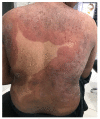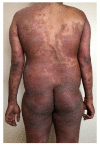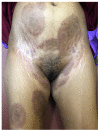Trichophyton indotineae-An Emerging Pathogen Causing Recalcitrant Dermatophytoses in India and Worldwide-A Multidimensional Perspective
- PMID: 35887512
- PMCID: PMC9323571
- DOI: 10.3390/jof8070757
Trichophyton indotineae-An Emerging Pathogen Causing Recalcitrant Dermatophytoses in India and Worldwide-A Multidimensional Perspective
Abstract
Trichophyton (T.) indotineae is a newly identified dermatophyte species that has been found in a near-epidemic form on the Indian subcontinent. There is evidence of its spread from the Indian subcontinent to a number of countries worldwide. The fungus is identical to genotype VIII within the T. mentagrophytes/T. interdigitale species complex, which was described in 2019 by sequencing the Internal Transcribed Spacer (ITS) region of ribosomal DNA of the dermatophyte. More than 10 ITS genotypes of T. interdigitale and T. mentagrophytes can now be identified. T. indotineae causes inflammatory and itchy, often widespread, dermatophytosis affecting the groins, gluteal region, trunk, and face. Patients of all ages and genders are affected. The new species has largely displaced other previously prevalent dermatophytes on the Indian subcontinent. T. indotineae has become a problematic dermatophyte due to its predominantly in vitro genetic resistance to terbinafine owing to point mutations of the squalene epoxidase gene. It also displays in vivo resistance to terbinafine. The most efficacious drug currently available for this terbinafine-resistant dermatophytoses, based on sound evidence, is itraconazole.
Keywords: ITS sequencing; Itraconazole; Trichophyton mentagrophytes; anthropophilic; antifungal; dermatophytoses; terbinafine resistance; tinea corporis; tinea cruris; tinea faciei.
Conflict of interest statement
The authors declare no conflict of interest.
Figures









References
-
- Süß A., Uhrlaß S., Ludes A., Verma S.B., Monod M., Krüger C., Nenoff P. Extensive tinea corporis due to a terbinafine-resistant Trichophyton mentagrophytes isolate of the Indian genotype in a young infant from Bahrain in Germany. Hautarzt. 2019;70:888–896. doi: 10.1007/s00105-019-4431-7. - DOI - PubMed
Publication types
LinkOut - more resources
Full Text Sources

